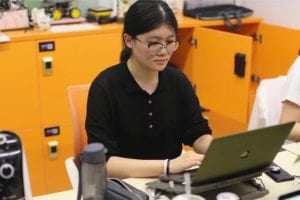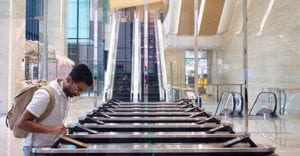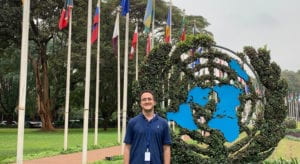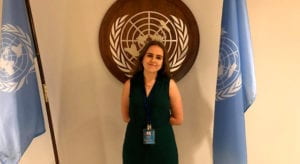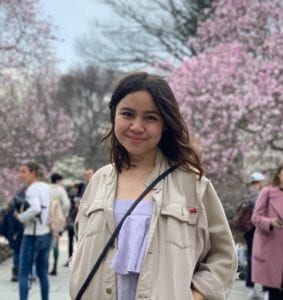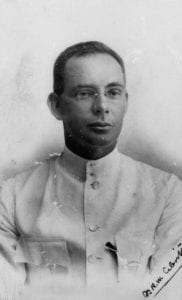Today we are in conversation with Sylvia Maier, Clinical Associate Professor at NYU’s Center for Global Affairs who recently completed a GRI Fellowship that took her to Berlin, Vienna, and Abu Dhabi. She shares her experiences in Berlin and how it has influenced her work.
Why did you decide to become a GRI Fellow and why did you do so in Berlin?
I’m a passionate urban walker and traveler, and have been interested for a long time in urban design and the gendered nature of public spaces, that is, how the design and use of public spaces reflect social power relations, if and how cities around the world are designed to meet the needs and lived realities of women (or not!), how woman-and LGBTQ-friendly they are, how safe, and who is included in the official conversations about zoning and design. My sabbatical was an excellent opportunity to launch a new research project, and so I started reading the academic and policy literature on the subject and found out that Berlin and my hometown, Vienna, are, in fact, pioneers in feminist urban planning and design! In addition to being home to women-designed spaces bith cities have even developed government guidelines (alongside several other large German cities) on how to gender mainstream urban planning and design. So, needless to say, applying for a GRI fellowship in Berlin was a no-brainer because it would put me into the heart of things, allow me to do site visits to woman-friendly locations, meet with local urban planners and designers, academics and activists, and learn first hand about the processes and conversations about making Berlin more inclusive. And I did! Plus, even though I speak German fluently and have been to Berlin several times, being able to tap into NYU’s considerable resources and professional network there would make field research so much easier. I was incredibly humbled by the generosity of my colleagues at the various universities there. Additionally, to my good fortune, two wonderful colleagues at NYU Berlin, Ares Kalandides and Salman Qureshi, with whom both I had the most thought-stimulating conversations, are teaching courses on queering urban spaces and the multicultural city. After my GRI fellowship in Berlin ended, I continued on to Vienna, where I did more field research and site visits to the iconic women-created spaces there, for example the famous Frauen – Werk – Stadt I and II. The fellowship allowed me to make some preliminary comparisons between feminist urban planning and design in three global cities: Berlin, Vienna, and Abu Dhabi.
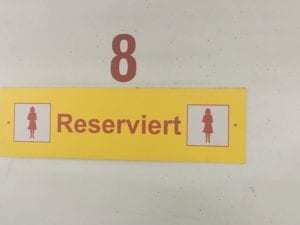
A housing project made for and by women in Vienna
What did you expect of the GRI fellowship? How was your experience and was it different from what you expected? What was most surprising or challenging?
I had a fantastic experience and it was exactly as I hoped it would be – and more. The team at NYU Berlin–Gabriella, Roland, Lygia and Karl–was exceptionally welcoming and helpful. They immediately made me part of the NYU Berlin GRI research family, organized for me to give a research seminar, introduced me to my fellow GRI fellows and likeminded colleagues, facilitated me sitting in on their classes, invited me to social gatherings and events, and provided bright and spacious office space. I was able to do extensive field research and site visits, and met with colleagues who work on urban studies, feminist urban planning, and migration at the Center for Metropolitan Studies at the TU Berlin and the Humboldt University. They all were incredibly generous with their time, insights and contacts. The most challenging thing for me was to get formal meetings with local government representatives. Their response rate was exactly zero. Overall, though, I couldn’t have wished for a better or more productive stay.
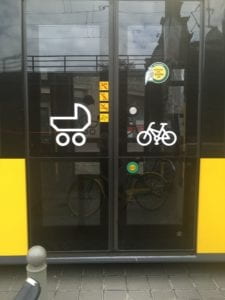
Berlin low floor tram car
I understand you recently gave a talk about your research at NYU Berlin entitled Feminist Urbanism: Designing Cities That Work for Women. Can you tell us about your research on this topic?
Yes! In the words of Katrina Johnston-Zimmerman (2017), “urban planning has a sexism problem.” This is not surprising as the overwhelming majority of urban planners, designers and architects are men, andwomen and underserved communities have been systematically excluded from architectural, urban planning and urban design decision-making processes, which, of course, has a tremendous impact on an individual’s identity, sense of safety, citizenship and belonging to the city. As I mentioned above, as a passionate urban walker and (single woman) traveler I’m acutely attuned to the gendered nature of public spaces and thus interested in the question whether urban design reflects the needs and lived realities of women, and what a city, or even a district, designed by women for women would look like? That is, how would its public transportation networks, commuter hubs, sidewalks, parks, playgrounds, public toilets, and shape of buildings be different from what we see in Berlin, Vienna, New York, Dubai, or Madrid today, all progressive global cities that have made inclusion and diversity part of their global “brand”? I’m interested in what can we learn from Vienna and Berlin about how feminist planners and designers (and/or their male allies) are working to “un-gender” and thus (re-)democratize urban public spaces and exercise their “right to the city” (Lefebvre 1981, 1968)? I have now done field research in three global cities—Berlin, Vienna, and Abu Dhabi—and what I have found so far is that there is no such thing as feminist urban planning because there is no agreement among advocates and activists, female and male alike, about what feministurban planning and design, and not just more women planners, actually entails. As a consequence, there is really no creative re/imagining of cities and social order and, most important, social power relations as they are reflected in the design and use of public spaces in any meaningful way. However, what we do see in Vienna and Berlin (and AD), for example, as a result of surveys of women city residents–and this is undoubtedly a good first step–is an emphasis on making public spaces safer and better lit, facilitating exercise (running, cycling) and

Exceptionally poorly designed stroller and wheelchair ramp in Bishkek, Kyrgyzstan
mobility, i.e. improving the accessibility of most public spaces and public transportation for pregnant people, people with strollers or a mobility impairment with dipped sidewalks, elevators, or low-floor buses, setting aside women-only parking spots in large parking garages, women-only cars on subway trains, creating family-friendly low-rise mixed use apartment complexes (with lots of safe green spaces and sitting areas, easily supervised playgrounds, a pediatrician and GP, a pharmacy, and a supermarket in the complex, etc). That is to say, we do see changes in infrastructural design with an emphasis on safety, easy access to commercial spaces, walkable mixed-use neighborhoods, and a deeply gendered understanding of parenting roles. I find this fascinating because all of these changes in fact reproduce and reinforce sexist assumptions about women’s perceived “needs” and gender roles – far from promoting feminism! On the other hand, ignoring women’s openly stated wishes and lived realities, for example as principal care givers or their safety concerns, just for the principle of it, is, of course, not an option. The next big question that emerged for me as a result of my research, is if and how cities in the most gender-equal countries in the world, Copenhagen, Reykjavik and Stockholm, have addressed this challenge, and/or whether having an explicitly feminist woman mayor, as Madrid does, makes a difference in women-related urban design issues.
How has your time in Berlin influenced your work and what comes next for you?
Walking, seeing, experiencing and living Berlin (and Vienna) with a resolutely feminist gaze, I gained a much better understanding of how Berlin’s (and Vienna’s) decisionmakers choose to understand “feminist urbanism,” how they implement it, and what their true priorities are. It was quite striking how little reality has in common with the hype, and how firmly entrenched economic and political interests are when it comes to resisting the creative re/imagining of urban or public spaces and making them more inclusive and also subversive of the patriarchal, capitalist, heteronormative social order. Essentially, there is no feministor queer urban planning and design in either city. Instead, the supposed concerns of the women city residents have been subsumed under the neoliberal, diversity, accessibility, and deeply gendered security paradigms. This made me even more determined to find out who actually sits at the table at these planning conversations. To that end, I will reach out to my NYU colleague Ares Kalandides, who is an urban designer and professor of place management, to explore this further jointly. In terms of next steps, I’m currently writing a paper on my Berlin and Vienna findings, which I hope to finish in September, and then present here at NYU’s Urban Research Day next year. NYU has a multitude of spaces where colleagues are conducting fascinating research on urban issues but there seems to be little attention paid to gender issues so come fall I look forward to starting conversations with colleagues at Wagner’s Marron Institute and the Urban Initiative. At the same time, I’m excited to continue my research on urban design and gender in public spaces in two other global cities—Abu Dhabi and Dubai—in January, where I’m leading my students on a Global Field Intensive. I will also apply for another GRI Fellowship in Berlin or Madrid next summer, in the latter to see whether having an explicitly feminist woman mayor, as Madrid does, makes a difference in women-related urban design issues.
Is there anything else that you’d like to share?
The GRI fellows program is a wonderful opportunity for faculty and graduate students to conduct research abroad, with all the support and resources of NYU while there. I really encourage everyone to take advantage of the program.
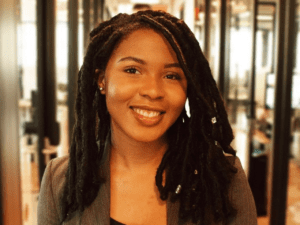 Alanis is a fourth year student at Gallatin where she studies power, identity and Black feminist ideology, with a minor in Web Programming and Applications. She is a New York native of Caribbean descent who will be studying in Accra, Ghana in Fall of 2019, where she hopes to gain an enriched experience that will not only aid her in her ongoing learning of how identity affects social navigations, but in her life as well.
Alanis is a fourth year student at Gallatin where she studies power, identity and Black feminist ideology, with a minor in Web Programming and Applications. She is a New York native of Caribbean descent who will be studying in Accra, Ghana in Fall of 2019, where she hopes to gain an enriched experience that will not only aid her in her ongoing learning of how identity affects social navigations, but in her life as well.


